 On December 3, according to his own confession, Naeem Davis, a 30-year-old mentally disturbed homeless immigrant from Sierra Leone, allegedly pushed to the subway tracks at the 49th St. station of the Q train in Manhattan a drunken 58-year-old Korean immigrant, Ki-Suck Han, who died seconds thereafter, struck and crushed by an incoming train.
On December 3, according to his own confession, Naeem Davis, a 30-year-old mentally disturbed homeless immigrant from Sierra Leone, allegedly pushed to the subway tracks at the 49th St. station of the Q train in Manhattan a drunken 58-year-old Korean immigrant, Ki-Suck Han, who died seconds thereafter, struck and crushed by an incoming train.
Han’s gruesome death did not initiate a public debate over either (a) ways to make the New York City subway platforms safer or (b) ways to make New York City as a whole safer by providing better care for and supervision of its homeless population, especially the component thereof that needs psychiatric attention and psychotropic medication if not institutionalization. Instead, it kicked off a furious debate over the ethics of photographing crises, large and small, in which lives are immediately at stake, and the appropriateness of publishing the resulting images.
This issue arose because R. Umar Abbasi, a freelance photojournalist coincidentally present at the scene, made at least three images of the tragedy as it unfolded. One of these shows the victim, his back to the camera with the train bearing down on him. It ended up on the front page of the Tuesday, December 4 edition of the New York Post, for whom the photographer was on another assignment when he made the image. Subsequent to its publication, this image and its genesis have evoked a barrage of commentary centered around two questions:
● Did Abbasi have a moral obligation to try to help Han to safety that trumped his making images of the man’s plight?
● Did the Post violate journalistic ethics by publishing the images, especially the one it used on its front cover?
Truth or Consequences
Abbasi has claimed that, positioned too far from the victim to reach him in time and pull him to safety, he made a split-second decision to try to alert the train’s motorman by repeatedly setting off his digital camera’s flash while running toward Han. If so, the hastily conceived strategy demonstrably didn’t succeed — though the motorman has indicated he did see the flashes — but did result in what Abbasi asserts was the unintended production of the three published images (and perhaps others).
 London Shearer Allen has debunked much of Abbasi’s several versions of his role in the event in two articles published by iMediaEthics.org: “Clues that Abbasi lied about New York Post subway photo?” datelined December 4, 2012, and “Measuring Subway Platform Discredits NY Post Abbasi Subway Photo Tale” from December 7, 2012. In these two pieces Allen actually conducts the kind of exemplary investigative journalism that should underpin serious critical commentary. With a team, he went to the station, measured the distances involved, recreated the photographs, compared them to several different accounts of his actions by Abbasi, and showed that “Abbasi’s own words contradict his photographs when the images are reconstructed using subway platform measurements.”
London Shearer Allen has debunked much of Abbasi’s several versions of his role in the event in two articles published by iMediaEthics.org: “Clues that Abbasi lied about New York Post subway photo?” datelined December 4, 2012, and “Measuring Subway Platform Discredits NY Post Abbasi Subway Photo Tale” from December 7, 2012. In these two pieces Allen actually conducts the kind of exemplary investigative journalism that should underpin serious critical commentary. With a team, he went to the station, measured the distances involved, recreated the photographs, compared them to several different accounts of his actions by Abbasi, and showed that “Abbasi’s own words contradict his photographs when the images are reconstructed using subway platform measurements.”
Based on these hard data, plus careful analysis of the images, Shearer asserts that Abbasi did not move much at all during the 20-some seconds in which he was aware of the situation; stopped to make each photograph, rather than doing so on the run; framed them carefully; was much closer to Han than he claimed, perhaps no further away than 24 feet; and was the person closest to Han during that period, thus the only one who might possibly have rescued him. This also put Abbasi the same distance from the alleged perp, whom he says was moving toward him along the narrow platform and who did in fact pass the photographer and exit the station from that end of the platform. (See photo below.)
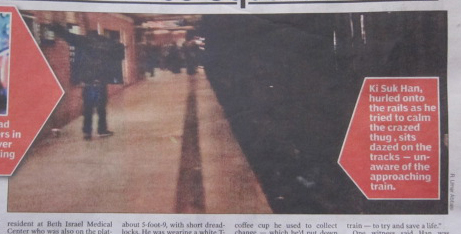
Abbasi’s Photograph #1: Davis, who allegedly pushed Han, at left. Han is sitting on the tracks, lower right. (Credit: photo of spread from NY Post print version. Subway photo by R. Umar Abbasi.)
Should Abbasi have risked moving past an obviously violent man, endangering himself, in order to rush to Han’s assistance? Could he have gotten there in time, and would he have had the physical strength to haul Han back to the platform? Did he consciously photograph the situation instead of trying to help? Is it reasonable to expect anyone to make a complex, life-threatening decision under duress in a few seconds and expect that choice to embody the spirit of self-sacrifice? Did Abbasi, after the fact, concoct a self-serving story full of holes to cover up his split-second decision to document the event instead of participating in it?
Some of these questions Abbasi could perhaps answer, assuming he has access to his own inner workings and a commitment to truth-telling, though that could involve some recanting and I expect he doesn’t plan to elaborate further on the several variants of his story that he’s told so far. Others will never get answered, save speculatively: What are the odds of rapidly pulling up out of harm’s way a shocked, disoriented, and inebriated middle-aged man, even assuming his attacker doesn’t interfere with your effort? (Abbasi has said that, fearing for his own safety, he pressed himself against the platform wall as Davis moved past him, which would have cost precious seconds.)
The most useful way to approach this, I think, involves assuming that, in the worst-case scenario, when faced with the imminent death of a fellow citizen whom he might possibly have saved (but might well not have) at his own considerable peril, a professional photographer opted to make pictures of the situation rather than attempt to intervene in it, subsequently fictionalizing his onlooker role to mute criticism thereof.
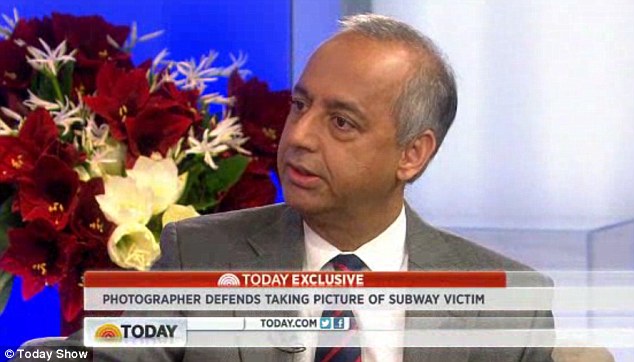
R. Umar Abbasi, Today Show, 12-5-12, screenshot.
“Opportunity confers moral responsibility,” Noam Chomsky wrote in a very different context. But of course opportunity comes in a spectrum of degrees. Try a thought experiment: Looking at the photos above and below, use a timer or count off 22 seconds — the estimated time between the making of these images and the moment the train struck Han — and ask yourself realistically how much opportunity you have to save the stunned man seated on the tracks, and whether you’d play those odds. Call me less than saintly, even chickenshit, but I’d certainly hesitate to put myself within reach of a belligerent individual strong enough to hurl someone at least my size onto the railbed, for the sake of a complete stranger.
As for the Post opting to publish this image: Sensationalistic, to be sure, especially with its screaming headline and subhead: “DOOMED: Pushed on the subway track, this man is about to die.” But we don’t see Han’s face, only his back. We know, from the large type, that the impact is imminent, will result in death and most probably gore. None of that’s visible, however; it’s all in our heads.
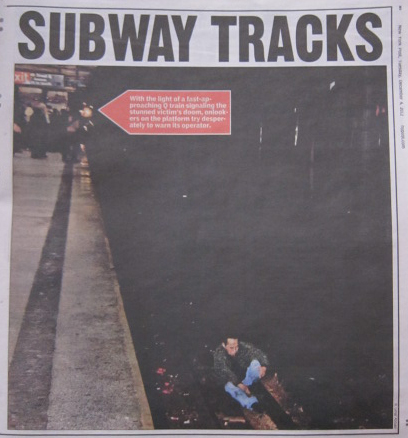
Abbasi Photograph #2: Han on the tracks after being pushed. Note train lights in the distance. (Credit: Photo from NY Post, print version. Subway photo by R. Umar Abbasi.)
I can also envision the same image with a different headline had the outcome gone otherwise: “SAVED: Pushed on the subway track, this man miraculously survived.” In which case no one would object to its publication, or castigate the photographer for not rushing to his assistance. In and of itself, it’s no more dreadful or offensive than a still from the Zapruder film of John F. Kennedy in his November 1963 Dallas motorcade seconds before the first bullet strikes, however horrific such an image may seem to those who know what’s about to happen.
So I don’t think the Post violated journalistic standards or common decency by putting this image of a newsworthy public event on its front page, or subsequently publishing the two that preceded it. And I can’t fault Abbasi for instinctively putting his own safety first and (if that’s what he did) photographing a situation in which any other effort on his part seemed unlikely to turn out well.
R. Umar Abbasi ≠ Kevin Carter
If Abbasi did concoct that narrative about racing toward Han and using his flash to alert the motorman, as close scrutiny of the visual evidence suggests, I wish he hadn’t. Not only because I prefer the truth, but because it actually serves him better and might help us in a reasonable public dialogue on the subject of the role of the photojournalist as citizen.
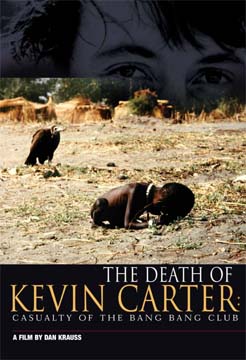
“The Death of Kevin Carter: Casualty of the Bang Bang Club” (2004), directed by Dan Krauss, poster.”
Commentary on this story has evoked comparison with Kevin Carter‘s stark 1993 image of a starving Sudanese child crawling toward a rescue station, with an expectant vulture in the background looking on. Publication of this image brought much condemnation down on Carter’s head for photographing the scene instead of helping the girl. A year later, shortly after receiving the Pulitzer Prize for that image, he committed suicide, attributed by some to feelings of guilt over his decision in that moral context.
In both cases (and others), there’s an assumption that photojournalists — and, by extension, journalists in general and, beyond them, anyone who serves in the role of designated professional witness to events — have some obligation under duress to abandon their posts, so to speak, in order to render humanitarian aid to individuals in distress. I didn’t buy that moral equation at the time in re to Carter, or others before him, and don’t give it credence now, in the case of Abbasi. I’ll detail my reasons in a subsequent post.
●
Correction: The original post identified Davis, the alleged perpetrator, as an African-American man. I’ve corrected that; he is an immigrant from Sierra Leone who became an American citizen.
[Update, July 17, 2017: A jury eventually found Davis not guilty on all counts, deciding that Han had initiated the confrontation and continued aggressively pursuing Davis down the platform, laying his hand on Davis and thereby making Davis’s response a matter of self-defense. See the New York Times report of the verdict by James C. McKinley Jr. and Hannah Alani.]
•
(For an index of links to all posts in this series, click here.)
•
This post supported by a donation from Yoshio Kishi.


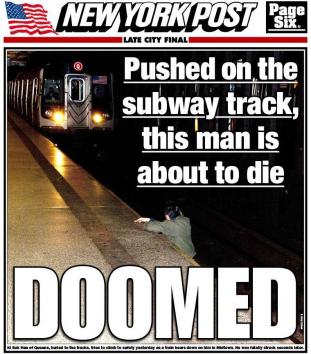
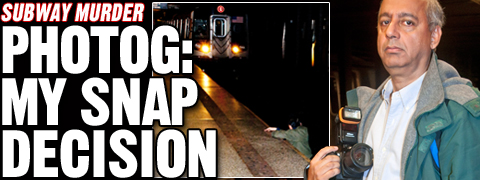




What I have observed over the years is that people in similar situations tend to rely on their training (or lack of it), for better or worse. My guess is he saw a photograph and took it, and hardly registered the threat of the offender, and made up the part about the flash warning. But to act differently, he likely would have to be part of a different society where we all place life-saving action as a primary value, and we practice it like Firemen in training. The same goes for moral action… it takes practice, despite the underlying framework in our genes.
Self-preservation predominates in the genetic framework of all species. Few creatures sacrifice themselves for others outside their immediate families. The morality involved in so doing is acquired, not innate. In most aboriginal languages, the word for “stranger” is synonymous with “enemy.”
Most people I know “place life-saving action as a primary value,” meaning that in a situation where they could save a life they would. With that said, I don’t think it’s incumbent on us to become a society of first responders. So I hesitate to second-guess a middle-aged adult with responsibilities to others and a backpack loaded with equipment who, in an instant, has to calibrate his course of action in relation to (a) an approaching sociopath, (b) an onrushing train, and (c) a man on the tracks yards away from and yards below him.
I was not under the impression that Mr.Carter was no longer with us . I am sorry that such a wonderful photographer is gone, I just saw the picture of the Vulture and the child and what’d to comment, I am so truly sorry.
Virginia